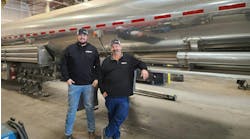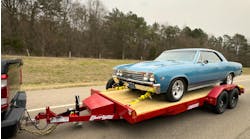Factory automation: Miller, B&W Hitches make case for robotic welders as all-encompassing solution for trailer manufacturers
Arc welding robots streamline operations, improve repeatability and, most importantly, help trailer manufacturers make money.
That was the message Brian Doyle, a sales manager with Miller Welding Automation, delivered during his presentation “Successful Implementation of Welding Robotics in a Changing Manufacturing Environment.”
Of course, robotic welders also are expensive, tricky to maintain and may leave shop employees feeling they’re being replaced. So are they the answer for the average small-town trailer manufacturing facility?
One Miller customer says emphatically, yes.
“Our theory has been based on implementing technology to keep people happy and productive,” said Mike Mueller, plant manager at Humboldt, Kansas-based B&W Trailer Hitches, which boasts 440 employees and 41 robots. “I’ve never stood up in front of the company and said you’re being replaced by a robot.
“We use robots to make our welders more productive, and for the most part the welders like them.”
Crawl, walk, run
The key to integrating robots in any operation is to start small.
For a shop that never has deployed even the most basic robot, it can be daunting and downright discouraging to contemplate installing the most complicated machine on the market, which can run as much as $400,000.
So, don’t do that, Doyle said.
“Start with something easy,” he said. “Start with a sub assembly. Start with two parts that go together. That way if the weld is off, people will figure out which part it is, because it’s only two parts. If you have a big assembly and you’re having trouble with it, it’s too many stack-up tolerances, too many upstream operations to keep track of.”
And by starting small, a business gradually builds it’s knowledge of and experience with robots, making integration more effective and helping ensure, if there is a problem, someone on staff has the know-how to solve it.
But if a trailer manufacturer is doing well with a staff of human welders, why bother? That’s easy: Direct labor savings.
Yes, the initial investment is substantial, but the return is exponential.
If the average manual welder makes one part per shift, the same worker feeding a robot will turn out two to three parts per shift, Doyle said, producing a productivity gain of up to 3:1.
“If you’re running two shifts, it can pay a direct labor savings of four salaries, so direct labor savings is the whole justification,” Doyle said. “People say, ‘Well, you’ll lose a little bit less weld metal,’ and all that stuff, which is true, but it’s decimal dust compared to the direct labor savings.”
By his calculation, if a shop is paying a welder $35 per hour for labor, the potential savings—with two welders working 40 hours per week, 50 weeks per year—is $140,000 annually, assuming full utilization, and potentially more.
But to fully utilize the robot’s skill set, it’s important to vanquish variation.
“You should be trying to squeeze variation out of everything that you can in your process—all your upstream processes, your spec-ing and ordering your materials, everything—because variation is the enemy,” Doyle said. “If you can get rid of your variation, you can automate successfully and make money.”
Robot underlords
Manual welders aren’t going away (even if they are harder to find) because the robots can’t rival their judgement, Doyle said. They simply do what they’re programmed to do, without the ability to make decisions.
But robots rout the humans in repeatability every time.
Program and maintain the robot correctly, and it will consistently churn out parts for years. Mueller said B&W has one Miller robot with 25,000 arc-on hours that’s still going strong. Manual welders, on the other hand, will have good days and bad days, but they’re also going to help protect the robot from its No. 1 enemy—gaps.
As a rule of thumb, Doyle said, weld joint repeatability in all three planes should equal one-half times the wire diameter, ie a .045-inch wire should have a +/- repeatability of .023 inches, and gaps must be sized, located and weldable to keep the robot running and avoid downtime, which is the key to profitability.
“Talk to your manual welders who are welding these parts and say, ‘What do you see with these?’ because they’ll tell you,” Doyle said. “They live with it every day … so listen to the guy because he’ll tell you what the problem is.”
If parts vary, and they’re fitting together too tightly or leaving a gap, there are tools to help, including touch sensing and through arc seam tracking, which requires additional hardware and training, but works well, Doyle said.
Selecting quality parts is key, and so, too, is picking the right people. Doyle recommends training at least two operators and one supervisor, depending on the size of the operation, and ideal candidates are young people with a knack for programming who are willing to learn welding.
“A home run is a welder who’s a gamer and has spatial awareness,” Doyle said.
Meet and beep
There are many different types of robot cells, or complete systems, in manufacturing, including manual table, servo table, H-frame head/tailstocks, robots between head/tailstocks, and Ferris wheel cells.
The table, H-frame and Ferris wheel cells have a single point for loading parts and unloading finished assemblies, maximizing throughput.
However, when it’s time to change a part or setup, the cell is going to be down.
“If you’ve got a gillion and one things to do, this is the kind of cell you want,” Doyle said. “You want that guy standing there putting new parts in, taking finished parts out, and so on.”
With the side-by-side robot cell, the robot is mounted between two servo-controlled head and tailstocks, typically with at least 10 feet between faceplates, providing room for larger parts and the flexibility to load Side A while the robot welds Side B. However, operators must move between stations.
Single-station cells are useful for pre-tacked parts with long cycle times. They minimize work-in-progress inventory and capital investment while maximizing operator utilization. Dual-station cells are good for long parts that need to be turned and provide the best solution for high-mix/low-volume shops.
Maximizing uptime
Fixturing, supplies and maintenance are key elements in determining a robot’s efficiency and minimizing downtime.
The fixture helps the robot identify where the welding is needed, hold the part in position during the process and maintain the part’s integrity. Fixtures must be customized for the robot and job, and, for robots that perform more than one job, easily switched in and out, typically in a tooling bed that secures the fixture.
Supplies are essential, too.
Doyle recommends keeping on hand a bulk supply of gas and wire (don’t use spools), and since replacing tips is cheaper than reworking a robot, it’s a good idea to change them proactively, typically once or twice a shift, he said.
Good collision detection and tool center point (TCP) procedures are essential when a robot goes down, and Doyle said neck straightening jigs are helpful, but the most important thing to remember, he said, in the event of a crashed torch, is to always return the torch where it was before the crash occurred.
“If you crash the torch, put the torch back where it was when you taught the program,” he said. “If you will do that, you will mint money with these machines. If you don’t do that, you will be touching up points for the rest of your life and not making the money that you could.”
Additional notes on uptime:
• Change the liner often. Compared to a manual station, a robot cell pumps three times the wire through the torch, and replacing liner, especially on front-loaders, is cheaper than reworking assemblies due to bad welds.
• Back up welding programs often. This process is automated on many newer systems.
• Conduct yearly preventative maintenance. Check ground cables, feed rolls and other cell gear regularly.
Time to run
When a manufacturing operation becomes more advanced with robotic automation, operators can begin to push the technology further, and turn the robot cells into a strategic advantage over their competitors.
Here are some pointers on optimizing weld travel speed and selecting the right fillet size:
• The faster the robot moves, the smaller the window for variation, so squeeze it out of everything. Use software tools to standardize torch angles. Some systems provide tools for controlling tip-to-work distance.
• Some systems also provide tools for optimizing speed. Remember—max speed depends on how consistently the weld joint is presented
• Make iterative production runs at higher speeds and track defect rate
• Once variation is under control, reduce the weld fillet size to the design print
• Over-welding is common but expensive. If the print calls for a 3/16-inch fillet and the operator uses 1/4-inch, the robot uses 78% more filler metal, shielding gas—and time. “The time is the thing that costs you,” Doyle said.
• Achieve the correct fillet size by speeding up, not lowering, the amperage.
By following a similar process, B&W Hitches achieved success with robots, including improved productivity and quality on high-liability welds, leading them to go so far as to package their parts upside down so the first thing the customer sees upon opening the box is the quality of the welds their machines produce.
Mueller said liability concerns were a driving force in his company’s robot adoption.
So were consistency, repeatability and workforce availability in an ever-changing manufacturing environment.
With finding quality, dependable welders becoming harder everyday—something Mueller never dreamed possible when he came out of high school—using robots helps his company provide a more appealing workplace for potential employees, who no longer are stuck in a shop breathing unpleasant fumes.
B&W’s robots feature custom-built hoods that funnel smoke out of the facility.
“When I came out of high school, a welder was somebody. I liked being a welder. It’s what I like doing. Now, it’s hard to find a kid who is proud to stand up and say, ‘I’m a welder,’” said Mueller, who admitted he’s worried he’ll eventually run out of candidates in the tiny town of Humboldt, 100 miles south of Kansas City.
He agreed with Doyle that video gamers make the best candidates these days. Plus, there are plenty of them.
“They’re very good at it,” he said.
“We can teach them how to weld, but you pair up your best welder with a young kid, and you’re doing two things. You’re putting two skill sets together—this mindset on welding, and this mindset on how to manipulate and move, and see the electronic stuff. And the other thing you’re doing is you’re establishing a work ethic.”
B&W currently has seven young programmers paired with an older welder, Mueller said.
“They need him, because he knows welding, and he needs them because they can manipulate this robot and do things he can’t do,” Mueller said.
Mueller said B&W chose Miller because of its robots’ durability and parts availability, and because Miller makes the welder and robot, so there’s no finger-pointing if there is a problem, unlike with an integrator who uses welders and robots from multiple manufacturers, then plays the blame game when a problem arises.
In fact, he said B&W stays away from integrators altogether.
In his experience, they sell a robot, set it up, charge a lot and leave. Then, when the machine breaks down, it takes time to get them back out, and while they’re there, they don’t really want to be, so they’re trying to get in and out quickly—which is why B&W opted to crawl before sprinting ahead with its robots.
“My guys wreck robots all the time,” Mueller said. “My guys find ways to wreck robots you would never even dream were possible.
“If you do it yourself, and you start simple and you learn the process, you’ve got all that knowledge in-house.”











